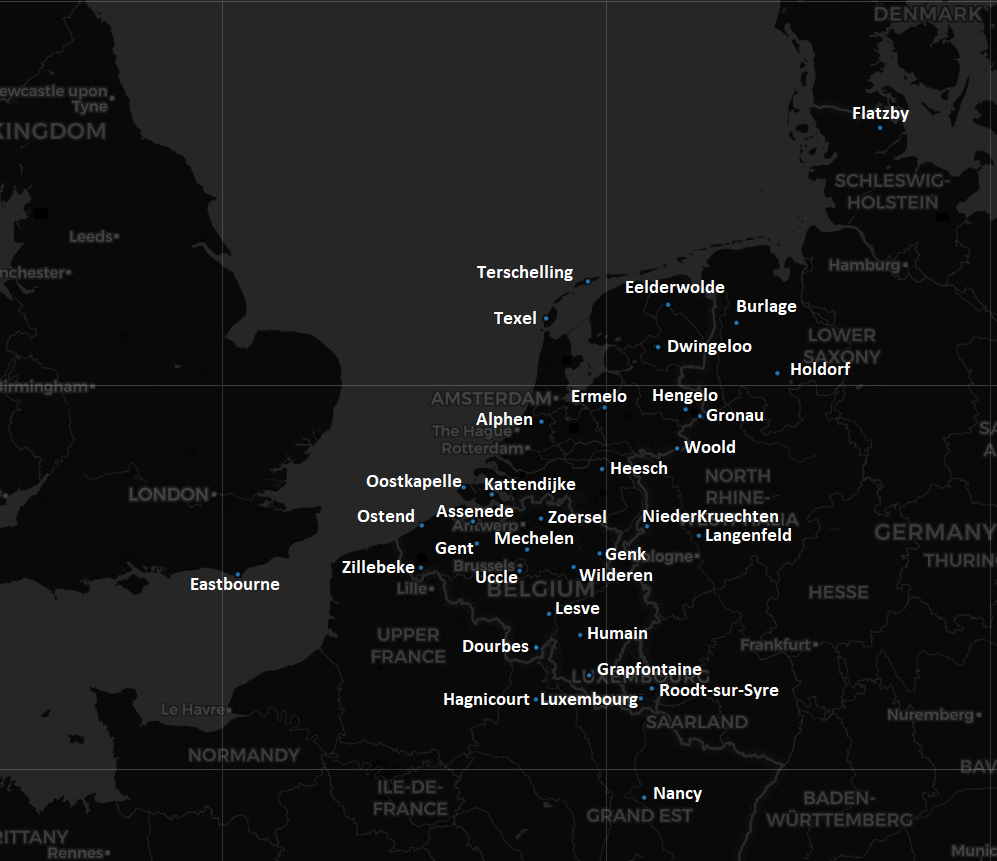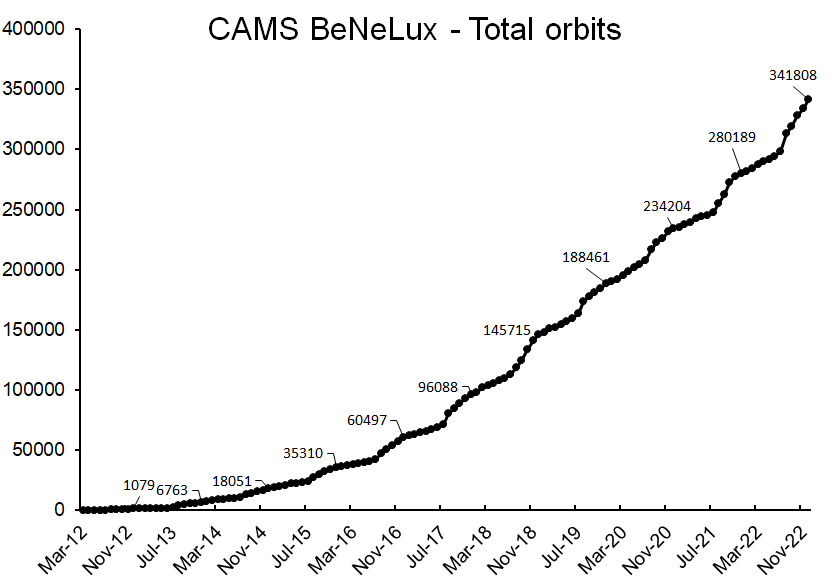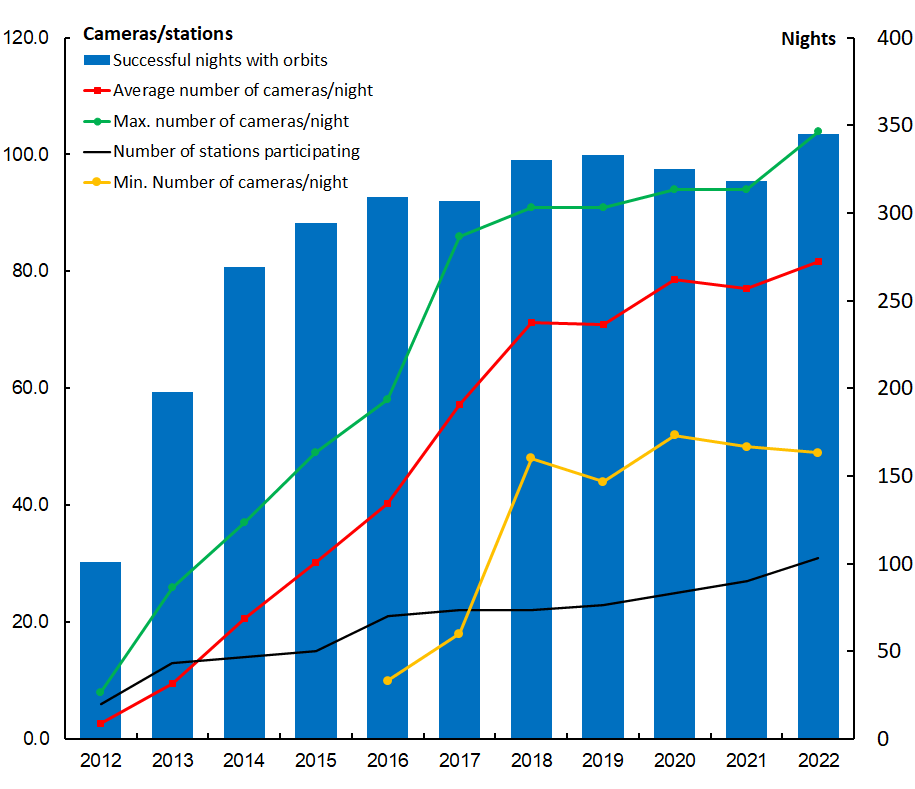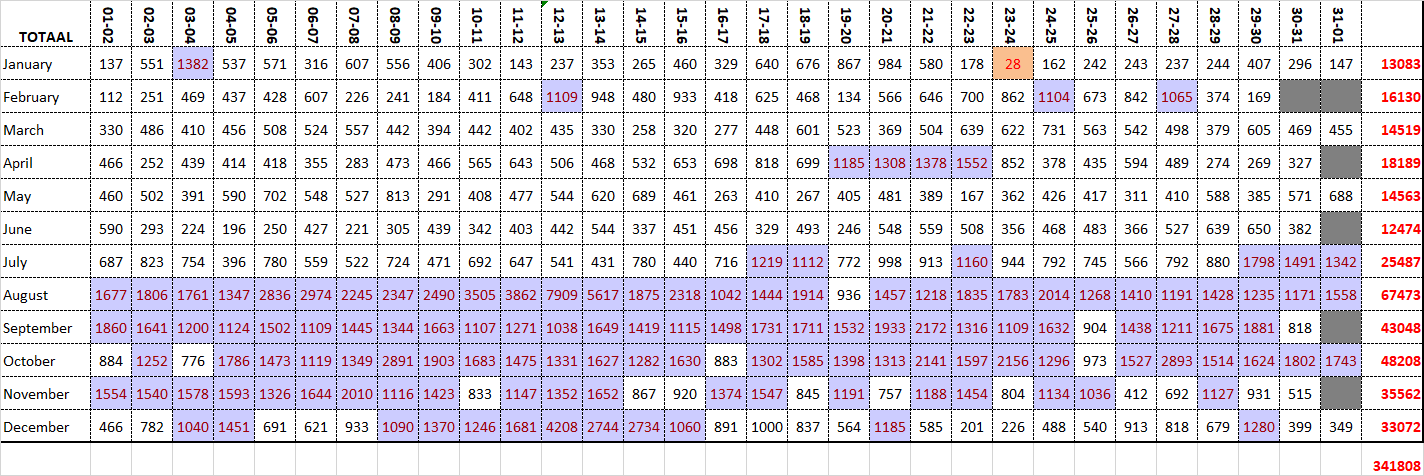Abstract: A summary of the activity of the CAMS-BeNeLux network during the year 2022 is presented. The year 2022 brought in general good conditions for astronomical observations. The best months were the months August and October. 61616 orbits could be collected during 345 different nights which corresponds to 94.5% of all 365 nights in 2022. The months March, July, August, October and December had the best scores ever for these months since the start of the network in 2012.
Introduction
The CAMS-BeNeLux network existed ten years in March 2022. After a strong growth of the network, especially in the years 2014 to 2017, the number of cameras and the number of participating camera stations has been quite stable since then. Some stations have stopped; others were added. In addition to the traditional Watecs H2 Ultimate, many RMS devices have been added to the network in recent years.
This year also saw the start of observations from two camera stations in Luxemburg, Philippe Schaack (Roodt-sur-Syre) participated with an RMS-camera since October, and Jan Thoemel (Luxemburg) participated with two Watecs since December. This means the network can now be called a real‚ BeNeLux-network. The number of cameras in France doubled when Pierre-Yves Péchart started to participate in August with two RMS-cameras in our network. Also, one camera station in England is participating now. Jim Rowe (Eastbourne, UK) is contributing with one RMS to the CAMS-BeNeLux network since June 2022.

Figure 1 – The locations of the sites participating in CAMS-BeNeLux in 2022. Most camera stations in the southern part are equiped with RMS cameras.
CAMS BeNeLux 2022 statistics
During the first two months we have had unstable variable weather. Clear nights were many times alternated with cloudy nights. As a consequence, the results for the months January and February were fairly average. Towards the end of February, the weather became more and more stable. These circumstances remained more or less stable for the rest of the year. As a consequence, results for each month from March until December were always one of the best in 10 years since the start of our network. Table 1 shows that a record number of orbits has been collected in March, July, August, October and December. Especially August with ~14000 orbits caught attention (Table 1).
Table 1 – Overview of the number of orbits during each month of 2012, and the ranking of this month since 2012.
| Month | #Orbits | Ranking |
| January 2022 | 1744 | 5th |
| February 2022 | 1939 | 4th |
| March 2022 | 3189 | 1st |
| April 2022 | 2543 | 3rd |
| May 2022 | 2160 | 3rd |
| June 2022 | 2228 | 2nd |
| July 2022 | 4499 | 1st |
| August 2022 | 14807 | 1st |
| September 2022 | 5446 | 3rd |
| October 2022 | 9749 | 1st |
| November 2022 | 5635 | 2nd |
| December 2022 | 7680 | 1st |
| Total 2022 | 61619 | 1st |
In total, we have collected 61619 orbits, a new record (Table 2, Figure 2). It should be no surprise that the year 2022 was the sunniest year since the start of the measurements in 1901 (Table 3). Approximately 2200 hours of sunshine are normal for regions near Lyon in southern France, but this exceeds the normal amount of sunshine in our regions (~1700 hours) with more than 25%.
Table 2 – Number of orbits obtained by CAMS-BeNeLux since 2012.
| Year | #Orbits |
| 2012 | 1079 |
| 2013 | 5684 |
| 2014 | 11288 |
| 2015 | 17259 |
| 2016 | 25187 |
| 2017 | 35591 |
| 2018 | 49627 |
| 2019 | 42746 |
| 2020 | 45743 |
| 2021 | 45985 |
| 2022 | 61619 |
| Total | 341808 |
Table 3 – The sunniest years since 1901.
| Year | Sunshine (hours) |
| 2022 | 2208.7 |
| 2018 | 2044.9 |
| 2003 | 2021.7 |
| 1959 | 1986.1 |
| 2020 | 1957.6 |

Figure 2 – The cumulative total number of orbits collected by CAMS-BeNeLux since 2012. Note the steep increase in the last months of 2022.
For our network, one of the most striking points was that we could collect orbits in every night between May 27 and October 12: a consecutive period of 139 nights with results!
During as few as 20 nights no orbits were obtained at all this year. So, we have achieved results in 94.5% of all nights in 2022. After a strong built-up of the network in 2017, we could collect orbits in ~89% of all nights in the years since then. This is a surprisingly high number, which means that our climate isn’t that bad as is often thought (Figure 3). Of course, one can only draw this conclusion if the cameras are functioning 7 nights on 7.

Figure 3 – The number of successful nights with orbits for each year (blue bars, right axis), the evolution of the minimum, average, maximum number of cameras and number of participating stations per year (left axis).
After a bit more than 10 years since the start of our network, we can conclude that expectations have been exceeded. As an example, the aim was to collect 100 orbits in every night of the year. Now, we see in Table 4 that this is achieved in all nights except January 23–24.
On the other hand, we have collected more than 1000 orbits in more than 100 nights already (Table 4). “Expectations are exceeded” then looks like an understatement. Of course, it is no coincidence that during the activity of the Perseids and Geminids the number of orbits reaches the highest numbers. Unfortunately, a few stations in the northern parts of the Netherlands suffered technical problems most of the year, otherwise results could have been even better.
CAMS worldwide
CAMS is a global project in which different networks around the world participate all using the same software. Results for all networks are given in Table 5. CAMS-BeNeLux contributed almost 12% of the total score for 2022.
Since the start of the network 2500000 orbits were collected worldwide, of which 341808 orbits or 13.7% by CAMS-BeNeLux.
We are looking forward to the year 2023. Not only thinking of what kind of surprises this year may bring, but also because CAMS results up to spring 2021 will be published. These results are the content for a new book by Peter Jenniskens. (Jenniskens, 2023).
Table 4 – Cumulated daily tally with the total number of orbits obtained by CAMS-BeNeLux for each calendar date, period 2012–2022.

Table 5 – Worldwide results of all CAMS networks in 2022.
| CAMS network | 2022 | 2021 |
| LOCAMS (Arizona, USA) | 106596 | 76232 |
| Namibia | 81197 | 99659 |
| BeNeLux | 61619 | 47023 |
| California (USA) | 52130 | 39683 |
| Chile | 49051 | 51350 |
| Australia | 38114 | 54893 |
| UAE | 32597 | 16294 |
| Florida (USA) | 26454 | 24554 |
| New Zealand | 16856 | 21661 |
| Arkansas (USA) | 18972 | 15868 |
| Texas (USA) | 19063 | 17449 |
| South Afrika | 7867 | 8726 |
| Maryland (USA) | 2384 | 5140 |
| Turkey | 1605 | 1323 |
| Brazil | 105 | 144 |
| India | 0 | 0 |
| Total | 514610 | 479999 |
Acknowledgments
Many thanks to all operators in the CAMS-BeNeLux network for their work and quick delivery of data. The CAMS-BeNeLux network was operated by the following volunteers in 2022:
Hans Betlem (Woold, Netherlands, Watec 3071, 3072, 3073, 3074, 3075, 3076, 3077 and 3078), Jean-Marie Biets (Wilderen, Belgium, Watec 379, 380, 381 and 382), Ludger Boergerding (Holdorf, Germany, RMS 3801), Günther Boerjan (Assenede, Belgium, RMS 3823 and 3824), Martin Breukers (Hengelo, Netherlands, Watec 320, 321, 322, 323, 324, 325, 326 and 327, RMS 319, 328 and 329), Seppe Canonaco (Genk, RMS 3818 and 3819), Bart Dessoy (Zoersel, Belgium, Watec 397, 398, 804, 805, 806, 3888 and RMS 3827), Tammo Jan Dijkema (Dwingeloo, Netherlands, RMS 3199), Isabelle Ansseau, Jean-Paul Dumoulin, Dominique Guiot and Christian Walin (Grapfontaine, Belgium, Watec 814 and 815, RMS 3814 and 3817), Uwe Glässner (Langenfeld, Germany, RMS 3800), Luc Gobin (Mechelen, Belgium, Watec 3890, 3891, 3892 and 3893), Tioga Gulon (Nancy, France, Watec 3900 and 3901), Robert Haas (Alphen aan de Rijn, Netherlands, Watec 3160, 3161, 3162, 3163, 3164, 3165, 3166 and 3167), Robert Haas (Burlage, RMS 3803 and 3804), Robert Haas (Texel, Netherlands, Watec 810,811, 812 and 813), Kees Habraken (Kattendijke, Netherlands, RMS 3780 and 3781), Klaas Jobse (Oostkapelle, Netherlands, Watec 3030, 3031, 3032, 3033, 3034, 3035, 3036 and 3037), Carl Johannink (Gronau, Germany, Watec 3100, 3101, 3102), Reinhard Kühn (Flatzby, Germany, RMS 3802), Hervé Lamy (Dourbes, Belgium, Watec 394 and 395, RMS 3825), Hervé Lamy (Humain Belgium, Watec 816, RMS 3821 and 3828), Hervé Lamy (Ukkel, Belgium, Watec 393), Koen Miskotte (Ermelo, Netherlands, Watec 3051, 3052, 3053 and 3054), Jos Nijland (Terschelling, Netherlands, Watec 841, 842, 843 and 844), Pierre-Yves Péchart (Hagnicourt, France, RMS 3902 and 3903), Tim Polfliet (Gent, Belgium, Watec 396, RMS 3820 and 3840), Pierre de Ponthiere (Lesve, Belgium, RMS 3816 and 3826) , Steve Rau (Zillebeke, Belgium, Watec 3850 and 3852, RMS 3851 and 3853), Paul & Adriana Roggemans (Mechelen, Belgium, RMS 3830 and 3831, Watec 3832, 3833, 3834, 3835, 3836 and 3837), Jim Rowe (Eastbourne, England, RMS 3829) , Philippe Schaack (Roodt-sur-Syre, Luxemburg, RMS 3952), Hans Schremmer (Niederkruechten, Germany, Watec 803) , Jan Thoemel (Luxemburg, Luxemburg, Watec 3950), Erwin van Ballegoij (Heesh, Netherlands Watec 3148 and 3149).
The cameras in Dourbes and Humain have been funded by STCE (Solar Terrestrial Center of Excellence).
Reference
Jenniskens P. (2023). Atlas of Earth Meteor Showers (in press).

